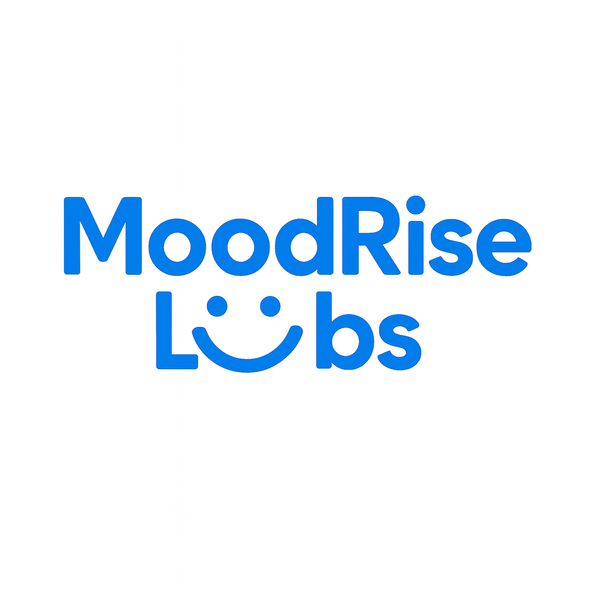How Stress Hormones Like Cortisol May Worsen Body Dysmorphic Disorder
Introduction
When you live with Body Dysmorphic Disorder (BDD), everyday moments — catching your reflection, preparing for social events, scrolling through photos — can feel like emotional landmines. Beneath the self-criticism and mirror-checking lies something deeper than thought patterns: a stress hormone imbalance that traps both brain and body in a cycle of fear and obsession.
At the heart of that cycle is cortisol, the body’s main stress hormone. It’s the chemical that keeps you alert in danger — but when it’s chronically elevated, it begins to reshape your perception, distort self-image, and intensify the anxiety that fuels BDD.
In this article, we’ll explore how cortisol interacts with brain chemistry, why stress amplifies body-focused obsessions, and how supplements, therapy, and lifestyle regulation can help you reclaim calm from the inside out 🌿.
Looking for supplements for This? Click here.
Understanding Cortisol: The Stress Messenger 🧬

Cortisol is produced by the adrenal glands, tiny structures sitting atop your kidneys. It’s part of your body’s HPA axis — the hypothalamic–pituitary–adrenal system — which governs the stress response.
When you face a threat (real or imagined), the hypothalamus in your brain signals the pituitary gland to alert the adrenals. In seconds, cortisol floods your bloodstream, raising blood sugar and sharpening focus to help you respond.
In short bursts, cortisol is life-saving. It helps you wake up, adapt, and stay alert. But when the stress never ends — as in chronic worry, perfectionism, or unresolved trauma — cortisol stays elevated.
And when that happens, it doesn’t just affect the body. It rewires the emotional and visual centers of the brain, feeding the loops that make BDD so painful.
The Cortisol–Brain Connection in BDD 🧠💥
People with Body Dysmorphic Disorder often live in a near-constant state of hypervigilance — scanning for flaws, anticipating judgment, or bracing for shame. This mental tension mirrors the physiological pattern of chronic stress.
Studies show that individuals with BDD and other obsessive–compulsive spectrum disorders have dysregulated HPA axis activity — meaning cortisol levels don’t rise and fall normally. Some produce too much cortisol; others too little after long-term depletion.
In both cases, the result is nervous system chaos: brain circuits that handle fear, self-perception, and reward become unbalanced.
The Amygdala: Fear Center Overdrive
The amygdala, which processes threat, becomes hyperactive under chronic cortisol exposure. This means neutral stimuli — like your own reflection — can trigger fear responses as if danger were present.
In BDD, the amygdala’s exaggerated response creates emotional intensity around appearance-related thoughts. A pimple, hair strand, or body angle can feel catastrophic because the brain literally perceives it as threat.
The Prefrontal Cortex: The Voice of Reason Goes Offline
High cortisol also weakens the prefrontal cortex, the rational part of the brain responsible for perspective, logic, and self-regulation.
That’s why it’s so hard to “talk yourself out of” obsessive thoughts. Under stress, the emotional brain hijacks the controls. The logical voice — the one that knows your perceived flaw isn’t real — gets drowned out by cortisol’s static.
The Hippocampus: Memory and Emotional Context
Cortisol shrinks the hippocampus, which stores contextual memory. When this area is compromised, it becomes harder to distinguish between past and present experiences — a key issue for people with trauma-linked BDD.
A comment made years ago (“you’re not attractive”) can feel fresh and real, reactivated by cortisol each time stress rises. The brain replays emotional pain as though it’s happening now.
Cortisol, Perception, and Self-Image 🪞
Visual processing is deeply tied to emotion. When cortisol floods the brain, it biases perception toward threat and imperfection.
People with BDD often describe feeling detached from their bodies — as though their reflection isn’t aligned with reality. Chronic stress worsens this dissociative perception, narrowing focus to tiny details while blurring the bigger picture.
This is why under high stress, body image distortions intensify. A bad day at work, a lack of sleep, or an argument can suddenly make your appearance feel unbearable. The mirror becomes a screen for stress, not reality.
How Cortisol Affects Neurotransmitters 🧪
Cortisol doesn’t act alone — it directly influences your brain’s neurotransmitters, altering how you think, feel, and perceive.
Serotonin
High cortisol reduces serotonin availability. Serotonin regulates mood and sensory filtering — without enough, neutral stimuli (like seeing your reflection) become emotionally charged.
Low serotonin also means fewer “safety signals,” making calm harder to sustain.
Dopamine
Cortisol spikes disrupt dopamine flow, which governs motivation and reward. This fuels the checking–relief–anxiety loop common in BDD: each mirror glance gives a brief dopamine hit, followed by a cortisol rebound of guilt and tension.
GABA and Glutamate
Cortisol suppresses GABA, the brain’s primary calming neurotransmitter, while stimulating glutamate, its excitatory opposite. This creates a mental environment of overstimulation — racing thoughts, muscle tension, and sensory sensitivity.
In essence, cortisol acts like a conductor turning up every stressful instrument in the orchestra while muting the calming ones.
The Body’s Response: When Stress Lives in the Muscles 💢
The mind and body don’t experience stress separately — they mirror each other.
When cortisol rises, the sympathetic nervous system activates: muscles tighten, breath shortens, digestion slows. Over time, this chronic tension sends feedback to the brain, reinforcing the belief that something is “wrong.”
You feel uncomfortable in your body, so your mind searches for an explanation — often landing on appearance.
“I must look bad” becomes the interpretation of what is actually a physiological stress signal.
This is one reason why body dysmorphia often worsens during periods of exhaustion or anxiety. The body’s physical discomfort becomes projected onto its image.
Cortisol and Sleep: The Exhaustion Loop 🌙
Poor sleep raises cortisol. High cortisol disrupts sleep. The result is a vicious cycle.
Sleep deprivation lowers serotonin, increases amygdala reactivity, and heightens emotional sensitivity. It also increases rumination, the repetitive thinking that fuels BDD symptoms.
People with chronic insomnia often report intensified self-criticism and distorted self-perception. Without proper rest, the brain loses its ability to self-regulate — making every mirror glance feel more charged.
Restoring sleep quality is therefore one of the most effective ways to lower cortisol and soften obsessive focus.
Supplements That Help Regulate Cortisol and Calm the Mind 🌿
While therapy and mindfulness are crucial for long-term recovery, nutritional support can help rebalance cortisol rhythms and stabilize neurotransmitter activity.
Ashwagandha: The Cortisol Whisperer 🌾
Ashwagandha is one of the most studied adaptogens for lowering cortisol. It helps the HPA axis return to baseline after stress spikes, reducing anxiety and stabilizing mood.
In BDD, ashwagandha can create a calmer baseline — fewer adrenaline surges when facing mirrors or social triggers. Over time, this balance enhances focus and emotional resilience.
Rhodiola Rosea: Resilience Without Fatigue 🌄
Rhodiola supports endurance under psychological stress by modulating cortisol and dopamine simultaneously.
For those with BDD who experience burnout from constant mental tension, rhodiola provides energy without overstimulation. It helps prevent the crash-and-spike pattern of stress hormones.
Magnesium: Relaxation from the Inside Out 🌙
Magnesium supports GABA activity and reduces cortisol production. It relaxes the muscles and nervous system, easing both physical and emotional tension.
Because magnesium deficiency is common among people with chronic anxiety, supplementation can noticeably reduce restlessness and irritability.
L-Theanine: Calm Focus Without Sedation 🍵
L-theanine, found in green tea, promotes alpha brain waves associated with relaxation and alertness. It lowers cortisol while enhancing serotonin and dopamine — the perfect trio for emotional balance.
Taking L-theanine before stressful events (like social interactions or body-image triggers) can smooth over reactive responses.
Looking for supplements for This? Click here.
Omega-3 Fatty Acids: Inflammation and Mood Stabilization 🐟
Cortisol’s long-term effects include inflammation in both the brain and body. Omega-3s reduce that inflammation, protect neural pathways, and restore healthy cortisol patterns.
They also improve communication between serotonin receptors, supporting emotional stability and reducing obsessive thought intensity.
Phosphatidylserine: The Cortisol Buffer 🧠
Phosphatidylserine helps regulate the stress response by signaling to the HPA axis when it’s safe to turn off cortisol production.
It enhances memory and focus while reducing the physical stress symptoms — racing heart, tension, and fatigue — that keep BDD loops active.
The Gut–Brain Axis: Cortisol’s Hidden Pathway 🦠
Chronic cortisol imbalances also alter gut microbiota, the bacteria that produce neurotransmitters like serotonin and dopamine.
When stress damages gut balance, inflammation increases — sending distress signals back to the brain through the vagus nerve. This feedback loop worsens anxiety, intrusive thoughts, and body discomfort.
Probiotic-rich foods (yogurt, kefir, kimchi) and prebiotic fibers (bananas, oats, onions) can help rebuild gut resilience.
In some cases, probiotic supplementation has been shown to lower cortisol and improve emotional regulation, making it a promising complement for people with BDD.
The Role of Breathwork and Nervous System Regulation 🌬️
Every anxious thought in BDD is amplified by shallow breathing.
When you breathe rapidly, your body interprets it as danger, prompting the adrenals to release more cortisol. Slow, intentional breathing reverses this process by activating the parasympathetic (rest-and-digest) system.
Try this simple practice:
Inhale slowly through the nose for four seconds.
Hold for two.
Exhale gently through the mouth for six.
After one minute, cortisol begins to decline measurably.
Practicing this before mirror exposure or stressful interactions retrains your nervous system to respond with calm instead of panic.
Want to try Breathwork? Click Here.
Emotional Triggers and Cortisol Spikes 💥
Not every cortisol surge comes from external stress. Emotional triggers — rejection, shame, or perfectionism — can provoke hormonal responses just as powerful as physical danger.
For people with BDD, even imagining judgment or imperfection can spike cortisol.
Learning to identify these emotional triggers is key to breaking the loop. With therapy, you can learn to recognize that your body’s physical stress is not proof that you’re unsafe — it’s just a chemical echo that can be regulated.
Over time, as emotional safety grows, the body stops producing cortisol in response to harmless stimuli.
Therapy and Somatic Integration 💬🧘
Healing from cortisol dysregulation in BDD requires more than cognitive understanding — it needs somatic integration, or teaching the body to feel safe again.
Cognitive Behavioral Therapy (CBT)
Helps restructure distorted thoughts that fuel the cortisol–fear cycle.
Somatic Experiencing
Uses gentle body awareness to discharge stored stress energy, teaching the nervous system that stillness is safe.
Mindfulness-Based Stress Reduction (MBSR)
Lowers cortisol through present-moment focus, helping individuals separate self-worth from appearance.
EMDR or Trauma Therapy
Addresses deeper emotional memories that keep the stress response on high alert.
These approaches, when paired with nervous system-calming supplements, help restore the body-brain feedback loop of safety that BDD disrupts.
Looking for online therapy ? Click Here.
Daily Habits for Cortisol Regulation ☀️
Small, consistent actions regulate the HPA axis better than any single intervention.
Start your day with sunlight exposure to synchronize circadian rhythms and lower morning cortisol spikes.
Eat protein-rich breakfasts to stabilize blood sugar (low glucose triggers cortisol).
Move your body daily — exercise burns off excess stress hormones and raises endorphins.
Prioritize 7–8 hours of deep sleep.
Reduce caffeine intake, which raises cortisol and can worsen anxiety.
These habits teach your biology that you are not under attack — even when your mind still believes you are.
The Healing Timeline ⏳
Cortisol regulation doesn’t happen overnight. It takes time for your adrenals, brain, and emotional patterns to trust safety again.
In the first few weeks of stress management, you might notice subtle shifts: calmer mornings, softer reactions to mirrors, slightly deeper sleep.
Over months, as your HPA axis recalibrates, you’ll experience longer stretches of peace. Thoughts become less charged, and body perception starts to normalize.
What was once an unrelenting storm becomes manageable waves.
The Cortisol–Compassion Paradox 💞
High cortisol makes compassion difficult — even toward yourself. When the stress response dominates, empathy shuts down, replaced by survival instincts like perfectionism or self-criticism.
This means one of the most healing things you can do isn’t control your body — it’s soften your inner environment.
Kindness to yourself lowers cortisol. Every moment of self-soothing — deep breathing, resting without guilt, speaking to yourself gently — tells your nervous system: I’m safe now.
And safety is the antidote to body dysmorphia.
Final Thought 🌿
Body Dysmorphic Disorder is often misunderstood as an obsession with beauty, but in truth, it’s an obsession born from fear — a nervous system trapped in stress chemistry.
Cortisol amplifies that fear until the mirror becomes a battlefield. But once you begin to regulate this stress hormone — through adaptogens, breathwork, nutrition, and therapy — the body starts to remember safety.
From there, self-perception shifts naturally. The image in the mirror becomes less threatening, more human, more whole.
You realize the battle was never about your reflection — it was about finding calm in your own body again.
And that calm, slowly and surely, is how healing begins 💫.
References
Phillips, K. A. (2009). Understanding Body Dysmorphic Disorder. Oxford University Press.
Feusner, J. D., et al. (2010). “Neural correlates of visual processing in BDD.” Archives of General Psychiatry, 67(2): 197–205.
McEwen, B. S. (2007). “Stress, brain function, and resilience.” Annals of the New York Academy of Sciences, 1113: 111–124.
Panossian, A., & Wikman, G. (2010). “Adaptogens and stress modulation.” Phytomedicine, 17(6): 481–493.
Lopresti, A. L., et al. (2019). “Ashwagandha and cortisol reduction.” Medicine (Baltimore), 98(37): e17186.
Kennedy, D. O. (2016). “Cognitive nutrition and the stress response.” Frontiers in Neuroscience, 10: 23.
Kimura, K., et al. (2007). “L-theanine and cortisol modulation.” Biological Psychology, 74(1): 39–45.
Hibbeln, J. R., et al. (2018). “Omega-3s and emotional regulation.” Progress in Neuro-Psychopharmacology & Biological Psychiatry, 80: 109–117.
Lanius, R. A., et al. (2018). The Neurobiology of Stress and Self-Perception. Routledge.
van der Kolk, B. A. (2014). The Body Keeps the Score. Viking.
Related Posts
-

Ashwagandha and Co-Dependency: Supporting Stress Resilience
Stress is more than a feeling—it’s a full-body signal that your system is overwhelmed. When the mind races and the body tenses, your hormones, breathing, and focus all shift into survival mode. Chronic stress doesn’t just affect emotions—it reshapes your nervous system, drains your energy, and clouds your clarity. Learning to understand and manage stress gently is the first step toward peace, balance, and true recovery. 🌿💫
-
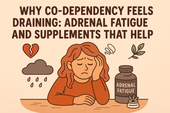
Why Co-Dependency Feels Draining: Adrenal Fatigue and Supplements That Help
The adrenal glands are small but powerful organs that sit above your kidneys, acting as your body’s built-in stress managers. They produce hormones like cortisol and adrenaline that help regulate energy, mood, and resilience. When they’re overworked from chronic stress or emotional exhaustion, fatigue and imbalance follow. Supporting adrenal health naturally can help restore calm, energy, and hormonal balance. 🌿⚡
-

The Link Between Anxiety, Co-Dependency, and Natural Support
Anxiety feels like living in constant alert mode—your heart races, your thoughts loop, and your body can’t find peace. It’s the nervous system’s way of preparing for danger, even when none exists. Understanding what’s happening in your mind and body is the first step toward calming the storm and restoring balance. 🌿💫
-
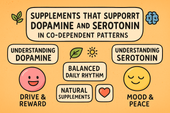
Supplements That Support Dopamine and Serotonin in Co-Dependent Patterns
Serotonin is the neurotransmitter of calm, confidence, and contentment. When it’s balanced, you feel peaceful and emotionally grounded. When it’s low, anxiety, mood swings, and emotional dependence take over. By understanding serotonin’s role in emotional health—and how to support it naturally—you can rebuild inner stability, improve relationships, and cultivate lasting happiness from within. 🌞💫
-

How Emotional Exhaustion in Codependency Impacts the Nervous System
The nervous system is the body’s communication network, connecting the brain to every organ and muscle. It regulates stress, mood, and emotion through a delicate balance of electrical and chemical signals. When overwhelmed, it can become dysregulated—leading to fatigue, anxiety, and emotional imbalance. Understanding how to calm and strengthen the nervous system is key to healing from chronic stress and emotional burnout. ⚡🌿
-
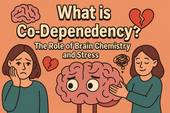
What Is Co-Dependency? The Role of Brain Chemistry and Stress
Stress is more than a feeling—it’s a full-body experience that begins in the brain and ripples through every cell. When cortisol surges and the nervous system stays on alert, your body can’t rest or recover. Over time, this constant tension affects energy, focus, mood, and even immune health. Understanding stress chemistry is the first step toward breaking free from burnout and finding calm again. 🌿
-

Creating a Supplement Stack for Motivation, Energy, and Anti-Procrastination
Motivation is the fuel behind every meaningful achievement—but it’s not just about willpower. It’s a mix of mindset, brain chemistry, and momentum. When energy, focus, and purpose align, action feels natural instead of forced. Learn how to harness motivation as a daily state, not a fleeting feeling.
-

Supplements for Building Consistency and Reducing Chronic Procrastination
Biochemistry is the bridge between biology and chemistry—the science of life at the molecular level. It explains how nutrients, hormones, and neurotransmitters interact to create energy, thought, and emotion. From brain function to muscle movement, biochemistry reveals the invisible processes that sustain health, balance, and vitality.
-
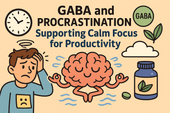
GABA and Procrastination: Supporting Calm Focus for Productivity
GABA is the brain’s natural calming messenger—a neurotransmitter that helps slow mental overactivity and ease stress. When GABA levels drop, focus fades, anxiety rises, and procrastination becomes more likely. By supporting GABA through nutrition, lifestyle, and supplements, you can restore calm clarity, improve focus, and take action with steady, balanced energy.
-
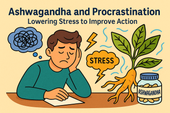
Ashwagandha and Procrastination: Lowering Stress to Improve Action
Science is the language of curiosity and discovery. It helps us understand the hidden patterns behind life, energy, and the universe. Through experimentation and critical thinking, science connects imagination to evidence—turning questions into knowledge. Whether through microscopes, molecules, or minds at work, science represents our endless pursuit of truth and innovation.
-

Neurotransmitters and Motivation: Supplements That Support Drive and Focus
Supplements can do more than boost physical health—they can also enhance mental clarity, focus, and motivation. Nutrients like omega-3s, magnesium, B vitamins, and adaptogens help balance neurotransmitters, stabilize mood, and support brain energy. When combined with good sleep, nutrition, and mindful habits, they can transform how your brain performs under stress.
-

How Stress Hormones Like Cortisol Fuel Procrastination (and What Helps)
Blood sugar isn’t just about physical health—it directly impacts focus, mood, and motivation. When glucose levels spike and crash, energy and attention do the same, fueling procrastination and brain fog. Learning how to stabilize blood sugar through balanced meals, mindful habits, and key nutrients helps keep your mind steady, focused, and ready to act.
-
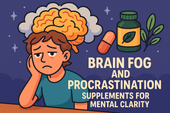
Brain Fog and Procrastination: Supplements for Mental Clarity
Brain fog can turn even simple tasks into mental hurdles. When your thoughts feel slow and unclear, procrastination often follows—making focus and productivity seem impossible. This article explores the biochemical and lifestyle causes of brain fog and reveals the most effective supplements for restoring mental clarity, focus, and sustained energy.
-

The Link Between Low Energy and Procrastination: Can Supplements Help?
Neurochemistry shapes how we think, feel, and act. When neurotransmitters like dopamine, serotonin, and GABA fall out of balance, it can lead to fatigue, anxiety, or lack of motivation—fueling procrastination and low mood. Understanding the brain’s chemical communication system helps us find ways to restore focus, calm, and emotional stability through nutrition, mindfulness, and targeted supplements.
-
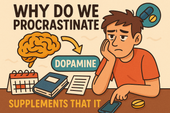
Why Do We Procrastinate? The Role of Dopamine and Supplements That Support It
Dopamine is the brain’s motivation messenger—the chemical that fuels focus, reward, and drive. When dopamine levels drop, even simple tasks can feel impossible to start. This article explores how dopamine shapes procrastination, motivation, and mental energy, along with natural supplements and daily habits that help restore balance and get things done.
-
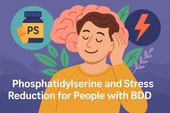
Phosphatidylserine and Stress Reduction for People with BDD
Stress is more than a mental state—it’s a full-body experience that affects hormones, brain chemistry, and emotional balance. For people with Body Dysmorphic Disorder (BDD), constant tension and worry about appearance can overload the nervous system. Learning how stress works and finding ways to calm it is key to breaking the cycle of anxiety and self-criticism.
-

How Antioxidants Like Vitamin C & E Support Mental Health in BDD
Antioxidants are the body’s natural defense against stress and inflammation. For people with Body Dysmorphic Disorder (BDD), oxidative stress can worsen fatigue, anxiety, and emotional imbalance. Nutrients like Vitamin C and E help protect brain cells, boost neurotransmitter function, and support a calmer, clearer mindset—building a stronger foundation for recovery.
-
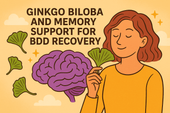
Ginkgo Biloba and Memory Support for BDD Recovery
Emotional regulation is the foundation of healing from Body Dysmorphic Disorder (BDD). When the nervous system stays in constant overdrive, even small stressors can trigger self-critical spirals. Learning to calm emotional reactivity helps restore clarity, confidence, and a sense of inner balance. By blending mindfulness, nervous system support, and self-compassion, you can retrain your brain to respond—not react—to emotion.
-
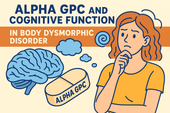
Alpha GPC and Cognitive Function in Body Dysmorphic Disorder
Mental fatigue can feel like your brain has hit a wall—thoughts slow down, focus fades, and motivation disappears. For people with Body Dysmorphic Disorder (BDD), chronic overthinking, emotional stress, and constant self-evaluation can deplete mental energy even further. Understanding what causes this cognitive exhaustion is the first step toward recovery—through rest, balanced nutrition, and targeted brain-supporting supplements.
-
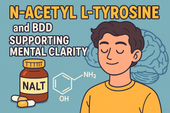
N-Acetyl L-Tyrosine and BDD: Supporting Mental Clarity
Chronic stress doesn’t just affect your mood—it reshapes your brain chemistry, weakens focus, and fuels the obsessive thought loops common in Body Dysmorphic Disorder (BDD). Over time, constant cortisol elevation drains mental energy and emotional balance. Learning to recognize and manage chronic stress is essential to restoring mental clarity, self-compassion, and resilience.
-

Chamomile and Lavender for Calming Obsessive Body Image Thoughts
The nervous system is the command center of our emotional and physical world—and in Body Dysmorphic Disorder (BDD), it often operates in overdrive. Understanding how the brain and body communicate under stress reveals why intrusive thoughts feel uncontrollable. Learning to regulate the nervous system through calm practices, nutrition, and supplements helps restore inner balance and emotional safety.
-
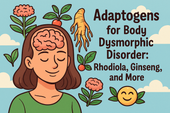
Adaptogens for Body Dysmorphic Disorder: Rhodiola, Ginseng, and More
Rhodiola rosea, often called the “golden root,” is an adaptogenic herb renowned for boosting stress resilience and mental endurance. For individuals with Body Dysmorphic Disorder (BDD), Rhodiola may help reduce fatigue, regulate cortisol, and enhance emotional balance. By supporting both mind and body, this powerful plant promotes calm focus, improved mood, and renewed energy to face daily challenges.
-
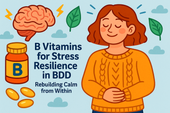
B Vitamins for Stress Resilience in BDD: Rebuilding Calm from Within
Biochemistry is at the heart of every thought, emotion, and reaction we experience. In Body Dysmorphic Disorder (BDD), chemical imbalances in neurotransmitters like serotonin, dopamine, and GABA can amplify stress and distort self-perception. Understanding the biochemistry behind mood and stress regulation offers a path toward healing—bridging the gap between emotional experience and the body’s molecular balance.
-
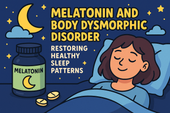
Melatonin and Body Dysmorphic Disorder: Restoring Healthy Sleep Patterns
Melatonin, the body’s natural sleep hormone, plays a vital role in helping people with Body Dysmorphic Disorder (BDD) restore healthy sleep cycles. When anxiety and obsessive thinking interfere with rest, melatonin levels often drop, leading to more emotional reactivity and distorted self-perception. This article explores how melatonin works, why BDD disrupts it, and how natural supplementation—combined with mindful routines—can help the brain and body finally find calm at night.
-
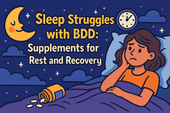
Sleep Struggles with BDD: Supplements for Rest and Recovery
When you’re living with Body Dysmorphic Disorder (BDD), restful sleep can feel impossible—but the right supplements can help reset your body’s natural rhythm. From magnesium and L-theanine to 5-HTP and ashwagandha, these nutrients support relaxation, lower cortisol, and enhance melatonin production. This article explores how supplements can calm the mind, ease nighttime anxiety, and promote true restorative sleep for emotional and physical recovery.
-
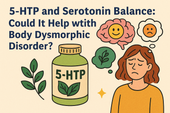
5-HTP and Serotonin Balance: Could It Help with Body Dysmorphic Disorder?
Anxiety can feel like a storm inside the mind—restless, overwhelming, and hard to control. In people with Body Dysmorphic Disorder (BDD), anxiety often fuels obsessive thoughts and self-criticism, creating a painful cycle of worry and self-doubt. This article explores the biological roots of anxiety, the role of neurotransmitters like serotonin and GABA, and how natural strategies such as mindfulness, supplements, and nervous system regulation can restore calm and mental clarity.
-
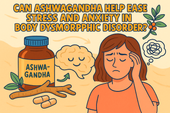
Can Ashwagandha Help Ease Stress and Anxiety in Body Dysmorphic Disorder?
Neurotransmitters like serotonin, dopamine, GABA, and acetylcholine are the chemical messengers that shape how we think, feel, and react to stress. In Body Dysmorphic Disorder (BDD), imbalances in these neurotransmitters can amplify anxiety, obsessive thinking, and emotional distress. This article explores how restoring healthy brain chemistry through nutrition, supplements, and mindfulness can help bring clarity, calm, and emotional stability.
-
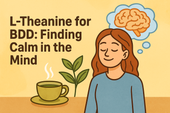
L-Theanine for BDD: Finding Calm in the Mind
Neurochemistry plays a central role in how we think, feel, and see ourselves. For those living with Body Dysmorphic Disorder (BDD), imbalances in neurotransmitters like serotonin, dopamine, and GABA can intensify anxiety, obsessive thoughts, and emotional distress. This article explores how regulating brain chemistry through supplements, mindfulness, and lifestyle changes can bring the nervous system back into harmony and restore inner calm.
-

Omega-3 Fatty Acids and Body Image Disorders: Supporting Emotional Health
Omega-3 fatty acids do far more than support heart health—they nourish the brain, stabilize mood, and may ease the emotional turbulence tied to body image disorders like BDD. This in-depth article explores how omega-3s regulate serotonin, dopamine, and inflammation, helping individuals reduce obsessive thoughts and rebuild self-acceptance. It also connects nutrition to therapy, mindfulness, and nervous system balance for holistic emotional healing.
-
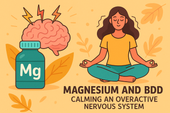
Magnesium and BDD: Calming an Overactive Nervous System
Magnesium plays a crucial role in calming an overactive nervous system—something people with Body Dysmorphic Disorder (BDD) struggle with daily. This article explores how magnesium supports relaxation, emotional regulation, and stress reduction while diving into the science behind its connection to brain chemistry. It also examines how combining magnesium supplementation with therapy and breathwork can help rebalance the body’s stress response, reduce obsessive thought patterns, and promote lasting nervous system calm.
-
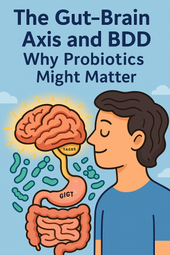
The Gut-Brain Axis and BDD: Why Probiotics Might Matter
The gut and brain are constantly in conversation — and that dialogue may shape how you experience Body Dysmorphic Disorder. By nurturing your microbiome with probiotics, prebiotics, and gut-healing nutrients, you can help rebalance serotonin, calm anxiety, and restore emotional stability from within 🧠🦠.
-
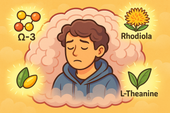
Brain Fog and Body Dysmorphic Disorder: Can Nootropic Supplements Help?
Brain fog often accompanies Body Dysmorphic Disorder, clouding focus and deepening emotional fatigue. Nootropic supplements like L-theanine, Rhodiola, and CoQ10 can help restore mental clarity, balance neurotransmitters, and bring calm energy back to the mind 🌿🧠.
-
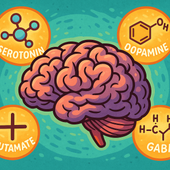
The Role of Neurotransmitters in BDD—and How Supplements May Help
Neurotransmitters like serotonin, dopamine, glutamate, and GABA shape how people with Body Dysmorphic Disorder perceive themselves. When these brain messengers fall out of balance, perception distorts — but targeted supplements can help restore calm, focus, and emotional regulation 🧠🌿.
-

What Is Body Dysmorphic Disorder? A Deeper Look at the Mind-Body Connection
Body Dysmorphic Disorder (BDD) isn’t just about appearance — it’s about perception. When brain chemistry, trauma, and stress distort self-image, the mind begins to see flaws that aren’t truly there. Healing starts by calming the nervous system and reconnecting mind and body 🪞🧠.
-
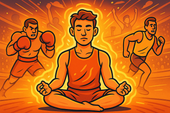
Keeping Calm in Competitive Sports: How to Train Your Mind, Body, and Chemistry for Peak Performance
Competitive pressure can overwhelm even the strongest athletes — but calm is trainable. By combining supplements like magnesium, L-theanine, and adaptogens with breathwork and mindset training, you can stay focused, balanced, and in control under any level of stress 🧠🏅.
-
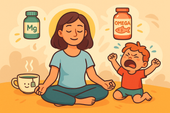
Supplements for Parents Facing Toddler Tantrums: Staying Calm When Little Emotions Run Wild
Toddler tantrums can drain even the most loving parent — but your calm is powerful. With the right supplements like magnesium, L-theanine, and ashwagandha supporting your nervous system, you can stay patient, grounded, and kind, even when emotions run high 🧸🌿.
-

Workplace Stress and Anger Management Support
Workplace stress can quickly turn into frustration — but calm is a skill you can train. By combining supplements like magnesium, L-theanine, and adaptogens with breathwork and mindset tools, you can stay focused, patient, and emotionally grounded no matter how intense the office gets 💼🌿.
-

How to Stay Patient With Family During Stressful Holidays
Holiday gatherings can stir up old stress and test your patience — but calm is possible. With nervous system support from magnesium, L-theanine, and adaptogens, plus mindful breathing and clear boundaries, you can stay centered, kind, and grounded even when family chaos unfolds 🎄💞.
-

Supplements to Keep Calm During Traffic Jams
Getting stuck in traffic doesn’t have to ruin your mood. With calming supplements like magnesium, L-theanine, and ashwagandha, you can train your body to stay relaxed and focused behind the wheel — turning gridlock into a moment of grounded patience 🚗🌿.
-
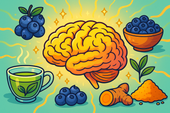
The Role of Antioxidants in Healing Brain Stress from Dissociation
Antioxidants protect the brain from the oxidative stress caused by trauma and dissociation. By neutralizing free radicals and supporting mitochondrial recovery, they help restore clarity, focus, and emotional balance — allowing the mind to heal at the cellular level 🌿🧠.
-
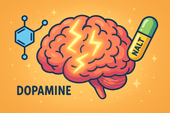
N-Acetyl L-Tyrosine (NALT) for Supporting Mental Clarity
N-Acetyl L-Tyrosine (NALT) fuels dopamine production — the neurotransmitter of focus and motivation. By supporting brain chemistry during stress, NALT helps restore mental clarity, energy, and alertness, making it easier to think clearly and feel present again ⚡🧠.
-

How Ginseng May Improve Focus and Energy in Dissociation
Ginseng helps combat the mental fatigue and fog that often come with dissociation. By supporting mitochondrial energy, balancing neurotransmitters, and regulating cortisol, it gently restores focus, motivation, and emotional presence — helping the mind reconnect with clarity and strength 🌿⚡.
-
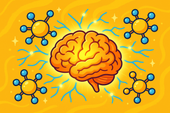
Phosphatidylserine and Dissociation: Supporting Cognitive Function
Phosphatidylserine helps calm the stress response by balancing cortisol, the body’s primary stress hormone. By lowering cortisol spikes, it protects memory, focus, and emotional stability — restoring clarity and mental presence for those struggling with dissociation 🧠🌿.
-
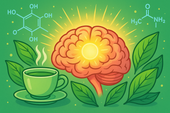
Can Green Tea Extract Help with Dissociative Brain Fog?
Green tea extract may help lift dissociative brain fog by supporting neurotransmitter balance, reducing inflammation, and enhancing energy at the cellular level. With its key compounds EGCG and L-theanine, it promotes calm focus, clarity, and emotional presence — helping you feel more alert and grounded 🍵🧠.
-
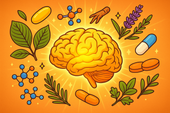
Building a Natural Supplement Stack for Dissociation Support
Building a supplement stack for dissociation means nourishing the brain and body back into communication. By supporting neurotransmitters, gut health, and energy balance through nutrients like magnesium, omega-3s, curcumin, and probiotics, you can help restore clarity, calm, and connection — one layer at a time 🌿🧠.
-

Chamomile and Lavender for Dissociative Anxiety Relief
Chamomile and lavender work together to calm dissociative anxiety by soothing the nervous system and restoring emotional safety. Their natural compounds balance cortisol, enhance GABA activity, and activate the vagus nerve — helping you feel grounded, connected, and at peace again 🌿💜.
-
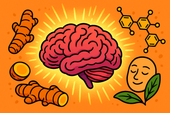
Curcumin for Inflammation and Mental Clarity in Dissociation
Curcumin, the golden compound in turmeric, does more than fight inflammation — it helps clear the mental fog often tied to dissociation. By calming neuroinflammation, balancing neurotransmitters, and supporting mitochondrial energy, curcumin can restore mental clarity, focus, and emotional presence 🌿🧠.
-
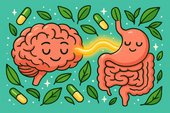
Probiotics and Dissociation: Exploring the Gut–Brain Axis
The gut–brain axis plays a vital role in emotional awareness and presence. When the microbiome is balanced, it supports serotonin production, vagus nerve activity, and calm focus. Probiotics help repair this connection — restoring safety, clarity, and the feeling of truly being in your body again 🌿🧠.
-
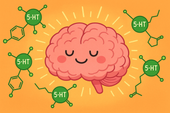
5-HTP for Dissociation: Supporting Serotonin and Emotional Stability
5-HTP helps bridge the gap between emotional numbness and stability by supporting serotonin production — the neurotransmitter that shapes mood, sleep, and sensory awareness. For people experiencing dissociation, 5-HTP may gently restore connection, presence, and emotional balance from the inside out 🌿🧠.
